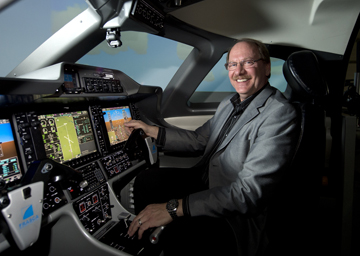Did You Know?: Holleman-Niswonger Simulator Center
March 21, 2013
 |
|
Bob Moser, the Holleman-Niswonger Simulator
Center's manager and an aviation technology instructor, sits inside one of the
center's high-tech plane simulators. Students in Purdue's professional flight
program log about 100 hours of simulator time by the time they graduate.
(Purdue University photo/Mark Simons)
|
The 13 flight simulators at Purdue's Holleman-Niswonger Simulator Center teach students to fly several planes using strikingly realistic equipment.
Located at the Purdue Airport, the simulator center is a single-story building primarily used by undergraduates in Purdue's professional flight program in the Department of Aviation Technology. Four of the center's simulators are called task trainers, and they teach students relatively simple concepts such as how to input flight plans.
Some of remaining simulators, however, are much more high-tech than the task trainers, which involve only a keyboard and display. For instance, the center contains detailed simulators of three Cirrus SR20 aircraft -- are primary and instrument training aircraft -- of a Phenom 100 jet and of a CRJ-700 airliner.
The Phenom jet simulator is particularly relevant to professional fight students' education because they are required to fly 10 hours in a real Phenom 100 jet, which the University owns, to earn their degree.
"The SR20 and jet simulators are identical in every regard to the flight decks of the real things," says Bob Moser, the Holleman-Niswonger Simulator Center's manager and an aviation technology instructor.
"Using these simulators, our students get very real, hands-on training in a controlled environment. They continue to receive this training throughout their time at Purdue, and the result is students who receive a very complete education."
Replicas of the inside and outside of their respective planes' cockpits, the SR20, the Phenom 100 and the CRJ-700 simulators also include an approximately 12-foot-high, hemispherical projection screen and a nearby computer, into which all details of each simulated flight are recorded.
All of the equipment inside the simulators' cockpits -- from the seats to the control buttons to the digitized displays -- is accurate to within 1/16 of an inch of the real planes' equipment.
This equipment allows student pilots and co-pilots to experience life-like taxiing, flying and landing experiences while simulating. The projection screen also can simulate any weather condition, and the instruments and displays inside the simulators respond exactly as their real counterparts would.
Using the simulators' nearby computers, faculty members can input almost any scenario imaginable to test students. For example, the computers can instruct the simulators to act as if a specific circuit breaker has failed, as if an engine has caught fire or as if the plane's landing gear has failed. These emergencies are rare in real life, Moser says, but the simulators offer a safe and controlled -- yet realistic -- environment to train for such events. The simulators can mimic every aspect of flight except for the motion involved.
In addition to the high-tech simulators, the center includes four simulators of older planes with steam-gauge, or analog, displays.
By the time students in the professional flight program graduate, they have logged about 100 hours of simulator time. For example, students log 40 hours in the Pheneom jet simulator -- 20 hours as the pilot and 20 hours as the co-pilot. These hours prepare them for the 10 hours of training they receive while flying the actual Phenom jet that Purdue owns. This extensive, hands-on experience often makes Purdue graduates strong candidates for jobs as pilots.
There are about 240 students in Purdue's professional flight program.
"When it comes to professional pilot jobs in the corporate or commercial world, many employers consider Purdue graduates some of the very best and most qualified in the country," Moser says.
"When combined with other aspects of our professional flight program, our simulators help students get the training and confidence they need to build successful careers in a very competitive field."
Writer: Amanda Hamon, 49-61325, ahamon@purdue.edu
